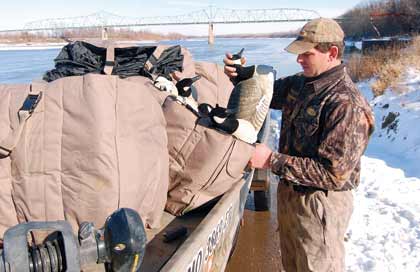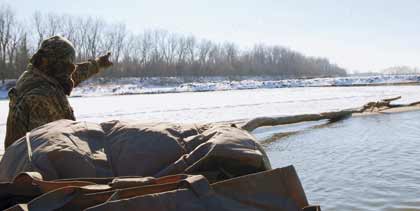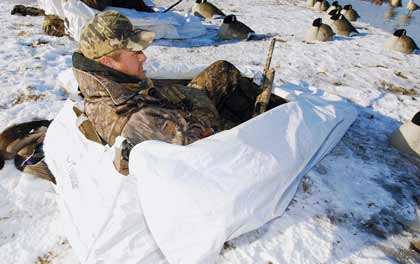November 03, 2010
By Mike Marsh
Tough gear and a tougher constitution on the bars of the Missouri.
By Mike Marsh
The Mighty Missouri River bisects its namesake state into north and south halves. The river also forms the northern half of Missouri's western boundary with Nebraska and Kansas. From Kansas City to St. Louis, where the Missouri River adds its flow to create an even mightier Mississippi River, the Missouri appears as a serene blue ribbon on any highway map. But such a cartographer's representation is a devious deception compared to what river hunters must cope with to be successful.
"The Missouri River is incredibly moody," said Tony Vandemore, a resident of Kirksville, MO. "The water level can be up one day then down the next. It's never at the same level two days in a row."
Advertisement
Added and subtracted with the rhythm of the Moody Mo's rise and fall are stronger or lighter velocities that can range from boulder-rolling torrents to complete docility. Such wild mood swings mean Missouri River hunters must be as flexible as the river itself. Increasing or decreasing snowmelt or rainfall contributions, combined with deep holes, shallow sandbars that can be covered with rocks and boulder-studded bottom and banks create a gauntlet to hunters. So why would anyone venture onto the river?
"It's one of the best places in all the Midwest to hunt ducks," Vandemore said. "That makes it worth the extra trouble."
Advertisement
Vandemore (Mallard Marauder) hunts in seven states throughout the Midwest. His extensive travels allow him to scout out many hunting locations. Nevertheless, the Moody Mo remains his favorite spot because it's the backyard playground of he and his fellow Mallard Marauders. They can go there anytime and shoot a limit of greenheads.
On a subfreezing afternoon, even discounting a high wind-chill factor, Terry Engberg of Brookfield, MO, Mark Bloss of Marsh Lake, MO, and Vandemore carefully launched Engberg's 21-foot john-boat at one of the many public boating access ramps along the Missouri. Snow and ice covered everything but the river's flowing surface and the concrete boat ramp. The ramp had been treated with rock salt by the highway department to enable hunters to launch from the steep path, which ran a couple of hundred feet, at slant that would have given a mountaineer pause to reconsider, down to the muddy water. Skidding on ice would have meant a watery grave for a boat trailer and its attached pickup truck.
"You've got to have a strong, thick aluminum hulled boat that can take the bangs and scrapes," Enberg said. "You have to learn where the safe passages are located or you'll ruin the propeller. The boat is going to bang against a rock every now and then, whether you're navigating the river or just pushing it into the water from a bar to retrieve a downed duck. It's a long way back to the ramp and there are not many hunters out here on weekdays to help you if you get into trouble by holing your boat or losing your propeller."
Indeed, there were only two other vehicles towing boat trailers parked at the ramp parking lot, although the ramp provided access to about 20 miles of river in either direction. While there are plenty of public ramps along the Missouri River, there are also many more miles of water. Scouting the long stretches is the only way to find mallard concentrations that are vital to the success of any hunt. Many wildlife refuges line the Moody Mo and some of the best places to hunt the river are near the refuges.
 Load up. |
Cell phone reception can be poor to non-existent with ramps spaced far apart and out in the watery, wintry wilds. Poor electronic communication means once you hit the river you should only depend on your pals and yourself to hunt and return home safely. These experienced hunters had wisely told others on dry ground where they would be hunting and when they could be expected to return home.
After his boat was launched and the vehicle and trailer safely parked on level ground, Engberg nosed the boat upriver. His face reddened in a navigationally induced headwind while I hid mine behind a woolen ski mask. He and his fellow red-cheeked hunters were constantly pointing out flocks of mallards taking flight. Occasionally there were also flocks of other species of ducks as well as Canada geese. Eventually, the boat slowed, turning from the current into a backwater eddy created by one of the many wing-dikes along the river. The wing-dikes, which were built by the U.S. Army Corps of Engineers, jut from the banks at a sharp perpendicular angle to the river and extend into the river for 200 feet or more.
Engberg said the heaped rows of rocks and river sediment help maintain the river's flow velocity, stabilizing the main river channel and keeping it deep enough for navigation purposes. But they also help ducks and consequently, duck hunters, by providing sheltered pools of water with sandbars where flocks of mallards can rest in the sunshine and out of the wind and slush ice flowing in the main channel.
The motor was switched off and the hunters stepped out. Slowly and carefully, they walked the boat toward a river sandbar upstream of a wing-dike. Their upper bodies bobbed slowly up and down their wader-clad feet stepped down into holes, then up onto boulders and cobbles. They stepped very carefully because nobody wanted to take a spill because of cobble rolling out from underfoot in the icy water. That's a sure way to end a river hunt in an instant.
They set more than 100 mallard decoys along a few dozen of Canada goose decoys. Some of the decoys were floaters, set along the edges of sandbars in the river current to give them motion, while others were and in the shallow waters of the calm eddy pool created by the wing dike. Other decoys were bank-bound models, with heavy weighted circular bases or weighted feet to hold them securely, but with bodies that were designed to bob and pivot around in the slightest breeze. All were in perfect condition, with not a spot showing chipped or scratched paint. Any mud splashes were carefully washed off with river water as the decoys were placed. A final touch was the addition of a couple of electrically operated spinning wing decoys. Further attracting motion would be added when necessary by using a manual goose flag from one of the blinds.
"Missouri River mallards get hunted pretty hard," Vandemore said. "It's important to use realistic decoys and set them in the same locations and positions as you see the real mallards when they're resting. You want to scatter them in little groups along the bars, with some other small flocks
in the water. If you leave a few open pockets downwind to give them a place to land, you'll have some good shooting. The location of those open pockets where the ducks try to land is really important when you're shooting from a sitting position."
 Mallards everywhere! |
Once the decoys were placed, the boat motor was fired up and the boat hidden downstream of the wing-dike. Ducks were already working the decoys, trying to land before Engberg returned to help the other hunters finish setting up their ground blinds. While many river hunters build and hunt from boat blinds, this trio of experts preferred keeping a low profile over the ease and comfort of hunting from a boat. They lay down in commercial ground blinds with flip-open covers. Since snow was everywhere, they had added white snow covers over the top of the original camouflaged fabric.
"Laying low keeps you out of the wind so you stay warm and also lets you hunt in the open," Engberg said. "Late in the season, ducks and geese shy away from anything that sticks up high enough to hide hunters. By using low-profile blinds, you can hunt right at the edge of the decoys, no matter how far up or down the water level may be."
A mixed flock of canvasback buzzed the decoys as the hunters were entering their blinds. Other ducks, including teal, gadwall, wigeon, and many others can round out a limit of ducks for Missouri River hunters. But they are considered only an incidental take to the goal of taking home bag limits of greenheads.
Once they were situated, there were so many mallards coming to their decoys, the hunters calmly took turns, with each hunters taking one greenhead at a time to make the afternoon's hunt last as long as possible. If a hunter took a bird with a band, there would be no question over whose duck it was. The methodical selection of hunters and ducks also saved ammunition, with no double shooting of the same duck. Vandemore killed his four mallards with as many shells and the other hunters fared nearly as well.
"When there are as many mallards as there are on the river, you can pick and choose your shots," Vandemore said. "When you're hunting from ground blinds, you have to set up so the birds are coming on your left side if you're a right-handed shooter. It takes a bit of practice to learn how to shoot lying down, but once you get the hang of it, it's really more about only picking out the shots you can hit within the shooting zone you can cover."
"You also have to learn to shoot without being able to swinging the gun with your entire body," Bloss said. "You can only use your upper body and arms or you'll shoot too far behind the ducks."
While Vandemore has an excellent Labrador retriever, he chose to leave the dog at home. Out in the open on the sandbar, the hunting position was so exposed that even the slightest movement--even a dog's wagging tail--could have given their presence away to decoying mallards.
"There's just no place on the bars for hiding a dog," he said. "The vast majority of the birds we shoot either land on the bar or in the shallows where we can easily wade out and pick them up."
The ducks came upriver mostly, flying over the wing-dike. They ignored the drab-painted aluminum boat resting at the ready on the downstream side. Vandemore said hunting upstream of the wing dike gave the hunters a slight element of surprise.
 Downtime on the river's bank. |
"You call to them as they come upriver and some of them want to land downstream of the wing-dike. But if you stay on the call, they'll pop up over it and see the decoys. They seemed surprised to see the decoys over the dike and usually come right on in without circling."
For ammunition, the experts used steel BBs in heavyweight, 31„2-inch 12-gauge loads. While there were very few cripples, ducks that were not killed outright were quickly dispatched with the large pellets. With the river current flowing so strongly along outside the bar and wing-dike, ducks had to be retrieved quickly. Otherwise, someone had to slog to the boat, shove it off and go after the duck in the river. Dead or crippled mallards don't necessarily prefer floating or swimming along the main channel, so picking them up among the boulder-strewn shallows could become a bit chancy when running the outboard motor. The retrieval process for a crippled bird would eat into valuable hunting time.
When the other hunters had filled their mallard limits, I tucked my camera away and entered a ground blind. My first drake mallard hit the water and I was initiated, the newest Mallard Marauder of the Moody Mo.
